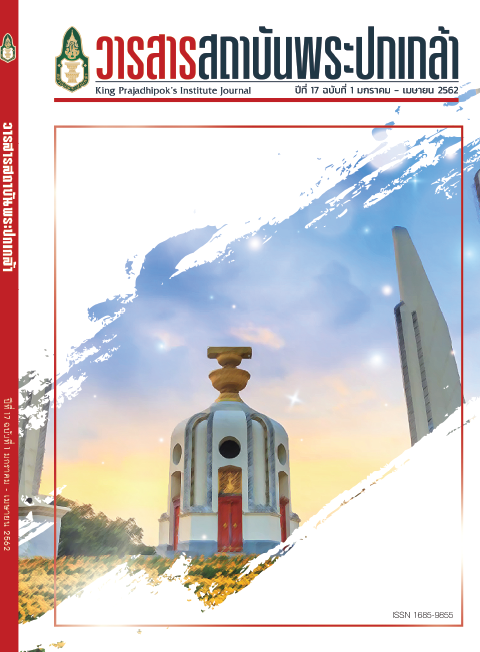Performing Arts and Politics
Main Article Content
Abstract
This article aims to study the relationship between performing arts and politics,focusing on the influence of politics over changes in performing arts. The study is based on documentation, interviews, observation, and the researcher’s experience. The results show that performing arts are related to politics in six dimensions:meaning, form, content, function, core, and changing. Performing arts are meant to be a communication tool of leaders. They represent the identity and aspect of the art itself and the whole society. The format can be both simple and complex. The content is found to be both real society’s situation and imaginary to express, thoughts, feelings, and needs. The main idea generally presents leadership features,national situation, and government policies: concepts, practices, which can be admiration, obedience, and opposition to the current leader. This can be seen in literature and extemporaneous rhymes. The systemic changes of Performing Arts can be slow, steady, and violent. The political revolution severely affected leaders and Performing Arts, with the abolition of the old art and the creation of the new one to suit the taste and policies of the new leaders, in order to change the behavior, ideology, and values of individual and society as they expect. This phenomenon can occur for a period of time or has an effect in the long run. However, the situation will be reversed when social crises lead to the revolution and the next cycle continues.
Article Details
@ 2020 King Prajadhipok's Institute The Government Complex Commemorating All Right Reserved.
References
กรมศิลปากร. (2515). กฏหมายตราสามดวง. พระนคร: องค์การค้าคุรุสภา.
จอมเกล้าเจ้าอยู่หัว, พระบาทสมเด็จพระ. (2547). ประชุมประกาศรัชกาลที่ 4. กรุงเทพฯ: มูลนิธิโตโยต้าแห่งประเทศไทย และมูลนิธิโครงการตำราสังคมศาสตร์และมนุษยศาสตร์.
ชุติมา มณีวัฒนา. (2561). ยุคฟื้นฟูศิลปะวิทยาการ Renaissance. สืบค้นจาก www.elfar.ssru.ac.th/chutima_ma/pluginfile.php/.../4.ละครฟื้นฟูศิลปวิทยา.pdf
ณัชชาภัทร อุ่นตรงจิตร. (2559). รัฐศาสตร์. กรุงเทพฯ : จุฬาลงกรณ์มหาวิทยาลัย.
ดำรงราชานุภาพ, สมเด็จพระเจ้าบรมวงศ์เธอ กรมพระยา. (2546). ละครฟ้อนรำ : ประชุมเรื่องละครฟ้อนรำกับระบำรำเต้น ตำราฟ้อนรำ ตำนานเรื่องละครอิเหนา ตำนานละครดึกดำบรรพ์. กรุงเทพฯ : มติชน.
ธนิต อยู่โพธิ์. (2531). ศิลปะละคอนรำ หรือ คู่มือนาฏศิลปไทย. กรุงเทพฯ : กรมศิลปากร.
ธำรงศักดิ์ เพชรเลิศอนันต์. (2560). สโมสรศิลปวัฒนธรรม เลือดสุพรรณ: ปลุกใจให้รักชาติและลุกรบ. สืบค้นจาก https://www.silpa-mag.com/club/art-and-culture/article_7167
นพมาส แววหงส์. (2543). ปริทัศน์ศิลปะการละครตะวันตก : องค์ประกอบของบทละคร. กรุงเทพฯ : โครงการเผยแพร่ผลงานวิชาการ คณะอักษรศาสตร์ จุฬาลงกรณ์มหาวิทยาลัย.
พจน์ ใจชาญสุขกิจ. (2561). โขนพระราชทาน ชุด “กุมภกรรณ” ตอน “โมกขศักดิ์”. สืบค้นจาก http://drphot.com/lifestyle/archives/1320
พิกแบร์. (2561). พระรามครองเมือง. สืบค้นจาก http://picbear.online/tag/พระรามค
มหาวิทยาลัยสุโขทัยธรรมาธิราช. (2561). 120 ปี ผ่านฟ้า ประชาธิปก: พระราชประวัติพระบาทสมเด็จพระปกเกล้าเจ้าอยู่หัว. สืบค้นจากhttps://library.stou.ac.th/odi/rama-7/history.html
ราชบัณฑิตยสถาน. (2493). สารานุกรมไทย ฉบับราชบัณฑิตยสถาน เล่ม 1. พระนคร : ราชบัณฑิตยสถาน.
วิจิตรวาทการ, หลวง. (2506). นาฏศิลปะ. พิมพ์ครั้งที่ 3. พระนคร : โรงพิมพ์พระจันทร์.
ศิริมงคล นาฏยกุล. (2557). นาฏยศิลป์ตะวันตกปริทัศน์. ขอนแก่น: หจก. โรงพิมพ์คลัง นานาวิทยา.
สยามไทย. (2561). ละครใน เรื่อง อิเหนา ตอน ท้าวดาหาบวงสรวง. สืบค้นจาก https://www.youtube.com/watch?v=N5u5Kfn2IFU
สำนักงานเลขาธิการสภาผู้แทนราษฎร สำนักวิชาการ กลุ่มงานพิพิธภัณฑ์และจดหมายเหตุ. (2561). เกร็ดความรู้ Thai Parliament Museum. สืบค้นจาก http://library2.parliament.go.th/museum/know.html
สุรพล วิรุฬห์รักษ์. (2543). นาฏยศิลป์ปริทรรศน์. กรุงเทพฯ : หจก.ห้องภาพสุวรรณ.
สุรพล วิรุฬห์รักษ์. (2549). นาฏยศิลป์รัชกาลที่ 9. กรุงเทพฯ : สำนักพิมพ์จุฬาลงกรณ์มหาวิทยาลัย.
สุวภัทร พันธ์ปภพ. (2561). เอกสารประกอบการสอน รายวิชา 0606111 ศิลปะการละคร 1 : Dramatic Arts. สืบค้นจาก https://fineart.msu.ac.th/e-documents/myfile/การวิเคราะห์บทละคร02.pdf
หนอนสุรา. (2547). รามเกียรติ์ ตำราบริหารฉบับไทย. กรุงเทพฯ : เทียนเล่มน้อย.
อนุมานราชธน, พระยา (2491). ศิลปะกับมนุษยชาติ กับร้องรำทำเพลง. พระนคร : โรงพิมพ์มิตรไทย.
MGR online. (2561). ร.6 ทรงวินิจฉัย ท้าวแสนปม” เรื่องปาฏิหาริย์เหลือเชือ ซ่อนความจริงที่เป็นไปได้ไว้. สืบค้นจาก http://ads.manager.co.th/asp-bin/viewgallery.aspx?newsid=9590000012001&imageid=3936161
MGR online. (2561). มาครง-ประธานาธิบดีฝรั่งเศส ชำแหละสารพัดนโยบายทรัมป์ ฉะ “อเมริกาเฟิสต์” สวนทางโลกยุคใหม่. สืบค้นจาก https://mgronline.com/around/detail/9610000041388
Appelbaum, Richard P. (1971). Theories of social change. U.S.A : Chicago.
Geertz, Clifford. (1980). Negara, The Theatre State in Nineteenth-Century Bali. Princeton, N.J.: Princeton University press.
Jackall, Robert. (1995). Propaganda. U.S.A : New York University press.
JoeyChernyim TV. (2561). สภาโจ๊ก 3/3. สืบค้นจาก https://www.youtube.com/watch?v=4003vShiUrw&t=115s
Manissa Vasinarom. (2017). Thai performing arts in King Prajadhipok’s Laws. สืบค้นจาก http://www.ijbtsjournal.com/images/column_1511026987/Tract%201_3.pdf


